Design and Experiment of Profiling Furrow-Ridge Terrain by Cane Leaf-Chopping and Returning Machine
Abstract
:1. Introduction
2. Materials and Methods
2.1. Working Conditions
2.1.1. Ridged Field Topography
2.1.2. Sugarcane Leaf Morphology
2.2. Overall Structural of the Leaf-Chopping and Returning Machine
2.3. Main Components and Parameter Design
2.3.1. Profiling Arrangement of Swing Blades
2.3.2. Flexible Hook Teeth Assembly
2.4. Dynamic Analysis of Leaf-Shredding Process
2.5. Field Experiment
2.5.1. Testing Conditions
2.5.2. Experimental Indicators
2.5.3. Test Scheme
3. Results and Discussion
3.1. Analysis of Cane Leaf-Crushing Effect
3.2. Approximate Modeling and Optimization Validation
3.3. Comparison on Improvements in Crushing Quality
3.4. Analysis of Resistance Characteristics
4. Conclusions
- This paper designs a profiling configuration of chopping and returning machine that adapts to the coverage characteristics of sugarcane leaves in furrow-ridge terrain. The device is powered by a tractor, and collects leaves attached to the furrow through a flexible hook teeth assembly. The rotating dense swing blades of unequal lengths cooperate with fixed blades to constitute a hitting space to chop the fed leaf materials. The profiling arrangement adopted effectively solves the problem of incompatibility with ridge cultivation terrain;
- The profiling parameters for terrain fit were determined based on the measured terrain change trends and combined with a dynamic analysis of the leaf-shredding process. Structural and operating factors that affect the cutting and picking capabilities were determined, such as blade length gradient, teeth spacing and feed speed. On this basis, CQR and CFD were selected as test indicators, and field experiments with three factors and three levels were conducted using the response surface method;
- The influence of various factors on CQR and CFD was significant, and mathematical regression models were established accordingly, which illustrated the rationality of studied parameter ranges. From ANOVA, the profiling design level of swing blades is the most critical among factors. The multi-objective optimal operation parameter combination of such a cane leaf-chopping and returning machine was obtained as: blade length gradient of 1.57 cm, teeth spacing of 6.84 cm and feed speed of 3.2 km/h. Utilizing this adaptive configuration, CQR and CFD were significantly improved by 60.50% and 47.99%, respectively, compared to the conventional machines. Meanwhile, crushed leaves were more thoroughly mixed with the soil and spread more evenly in the field;
- The effective value RSM of traction resistance under the optimized tool arrangement was 45.85% lower than that of the higher-level blade length. The stable operating characteristics demonstrated that it fitted well with the changing furrow-ridge terrain. The comprehensive crushing quality and resistance results can meet the agronomic practice requirements for the promotion and application of sugarcane leaf returning in ridge cultivation fields.
Author Contributions
Funding
Institutional Review Board Statement
Data Availability Statement
Conflicts of Interest
References
- Shukla, S.K.; Lal, M.; Singh, S.K. Improving bud sprouting, growth and yield of winter initiated sugarcane ratoon through tillage cum organic mediated rhizospheric modulation in Udic ustochrept under subtropical Indian condition. Soil Tillage Res. 2013, 126, 50–59. [Google Scholar] [CrossRef]
- Wang, Z.; Wang, Z.; Ma, L.; Lv, X.; Meng, Y.; Zhou, Z. Straw returning coupled with nitrogen fertilization increases canopy photosynthetic capacity, yield and nitrogen use efficiency in cotton. Eur. J. Agron. 2021, 126, 126267. [Google Scholar] [CrossRef]
- Ou, Y.G. Present situation and countermeasure of whole-process mechanization of sugarcane production in China. Mod. Agric. Equip. 2019, 40, 3–8+42. [Google Scholar]
- Yang, H.; Fang, C.; Meng, Y.; Dai, Y.; Liu, J. Long-term ditch-buried straw return increases functionality of soil microbial communities. CATENA 2021, 202, 105316. [Google Scholar] [CrossRef]
- Yin, H.; Zhao, W.; Li, T.; Cheng, X.; Liu, Q. Balancing straw returning and chemical fertilizers in china: Role of straw nutrient resources. Renew. Sust. Energ. Rev. 2018, 81, 2695–2702. [Google Scholar] [CrossRef]
- Li, Z.; Shen, Y.; Zhang, W.; Zhang, H.; Liu, L.; Wang, Z.; Yang, J. Effects of long-term straw returning on rice yield and soil properties and bacterial community in a rice-wheat rotation system. Field Crop. Res. 2023, 291, 108800. [Google Scholar] [CrossRef]
- Tang, H.; Xu, C.; Xu, W.; Xu, Y.; Xiang, Y.; Wang, J. Method of straw ditch-buried returning, development of supporting machine and analysis of influencing factors. Front. Plant Sci. 2022, 13, 967838. [Google Scholar] [CrossRef]
- Kumar, A.; Kumar, V.; Singh, B. Cellulosic and hemicellulosic fractions of sugarcane bagasse: Potential, challenges and future perspective. Int. J. Biol. Macromol. 2021, 169, 564–582. [Google Scholar]
- Kaab, A.; Sharifi, M.; Mobli, H.; Nabavi-Pelesaraei, A.; Chau, K.W. Use of optimization techniques for energy use efficiency and environmental life cycle assessment modification in sugarcane production. Energy 2019, 181, 1298–1320. [Google Scholar] [CrossRef]
- Zhou, H.; Zhang, J.; Xia, J.; Tahir, H.M.; Zhu, Y.; Zhang, C. Effects of subsoiling on working quality and total power consumption of high stubble straw returning machine. Int. J. Agric. Biol. Eng. 2019, 12, 56–62. [Google Scholar] [CrossRef]
- Ye, Z.; Wang, Y.; Tang, Y.; Qiu, Z.; Luo, W.; Ren, G.; Zhao, Q. Dynamic simulation analysis of the working process of the picking mechanism of a sugarcane leaf cutting and returning Machine. Appl. Sci. 2023, 13, 1620. [Google Scholar] [CrossRef]
- Lin, J.; Ma, T.; Li, B. Design and test of 1JHL-2 type straw deep burying and returning machine. Trans. Chin. Soc. Agric. Eng. 2017, 33, 32–40. [Google Scholar]
- Guo, Z.; Lu, C.; He, J.; Wang, Q.; Li, H.; Zhai, C. Design and Experiment of Active Spiral Pushing Straw Row-Sorting Device. Agriculture 2024, 14, 137. [Google Scholar] [CrossRef]
- Huang, W.H.; Yan, X.L.; Dong, X.H. Design and experiment on the 1GYFH type returning machine of grinding and mixed-buried sugarcane leaves. J. Agric. Mech. Res. 2018, 40, 140–144+165. [Google Scholar]
- Wu, T.; Hu, L.; Wang, G.; Hu, Z.; Yan, W.; Wang, B. Design and test of walking sweet potato (Ipomoea batatas) vines crushing and returning machine. Trans. Chin. Soc. Agric. Eng. 2017, 33, 8–17. [Google Scholar]
- Liu, P.; He, J.; Zhang, Z.; Lu, C.; Zhang, Z.; Lin, H. Kinematic characteristic analysis and field test of chopped stalk in straw retention machine based on CFD-DEM coupling simulation method. Trans. Chin. Soc. Agric. Mach. 2020, 51, 10. [Google Scholar]
- Qiu, Z.; Wang, Y.; Tang, Y.; Luo, W.; Ye, Z. Analysis of blockage and wrapping by leaves in the cutting mechanism of a sugarcane leaf shredder. Biosyst. Eng. 2021, 211, 152–166. [Google Scholar] [CrossRef]
- Li, Y.; Guo, C.; Yao, D.; He, N.; Zhang, X.; Wu, Z.; Li, Y. Design and experiment of banana straw crushing and returning machine with anti-wrapping device supported by flailing blade. Trans. Chin. Soc. Agric. Mach. 2021, 37, 11–19. [Google Scholar]
- Vayssade, J.A.; Jones, G.; Paoli, J.N. Towards the characterization of crop and weeds at leaf scale: A large comparison of shape, spatial and textural features. Smart Agric. Technol. 2023, 5, 100245. [Google Scholar] [CrossRef]
- Mou, X.; Liu, Q.; Ou, Y.; Wang, M.; Song, J. Mechanical properties of the leaf sheath of sugarcane. Trans. ASABE 2013, 56, 801–812. [Google Scholar]
- Wang, J.F.; Zhang, X.; Tang, H.; Wang, J.W.; Weng, W.X.; Yang, D.Z. Optimal design and experiment of deep-buried reverse rotating sliding cutting straw returning blade. Trans. Chin. Soc. Agric. Mach. 2021, 52, 28–39. [Google Scholar]
- Jia, H.L.; Jiang, X.M.; Guo, M.Z.; Liu, X.L.; Wang, L.C. Design and experiment of VL shaped smashed straw blade. Trans. Chin. Soc. Agric. Eng. 2015, 31, 28–33. [Google Scholar]
- Luo, W.H.; Wang, Y.X.; Tang, Y.Q.; Qiu, Z.G.; Zhao, Q.X.; Ren, G.F.; Ye, Z.L. Numerical simulation and experiment on wrapping characteristics between sugarcane leaves and rotating roller of returning machine. Comput. Electron. Agric. 2022, 202, 107441. [Google Scholar] [CrossRef]
- Weng, X.; Tan, D.; Wang, G.; Chen, C.; Zheng, L.; Yuan, M.; Hu, X. CFD simulation and optimization of the leaf collecting mechanism for the riding-type tea plucking machine. Agriculture 2023, 13, 946. [Google Scholar] [CrossRef]
- DB45/T 561-2008; Operation Quality of Cane Leaf Crushing and Returning Machinery. Guangxi Zhuang Autonomous Region Agricultural Mechanization Technology Promotion Station: Nanning, China, 2008.
- Lalremsang, P.; Upadhyaya, K.; Sahoo, U.K.; Singson, L. Effect of legume leaf mulch and fertilizer on soil quality and rice yield for small scale production. Acta Ecologica Sinica 2023, 43, 861–868. [Google Scholar] [CrossRef]
- Li, X.; Fu, J.F.; Zhang, D.X.; Cui, T.; Zhang, R. Experiment analysis on traction resistance of vibration subsoiler. Trans. Chin. Soc. Agric. Eng. 2012, 28, 32–36. [Google Scholar]
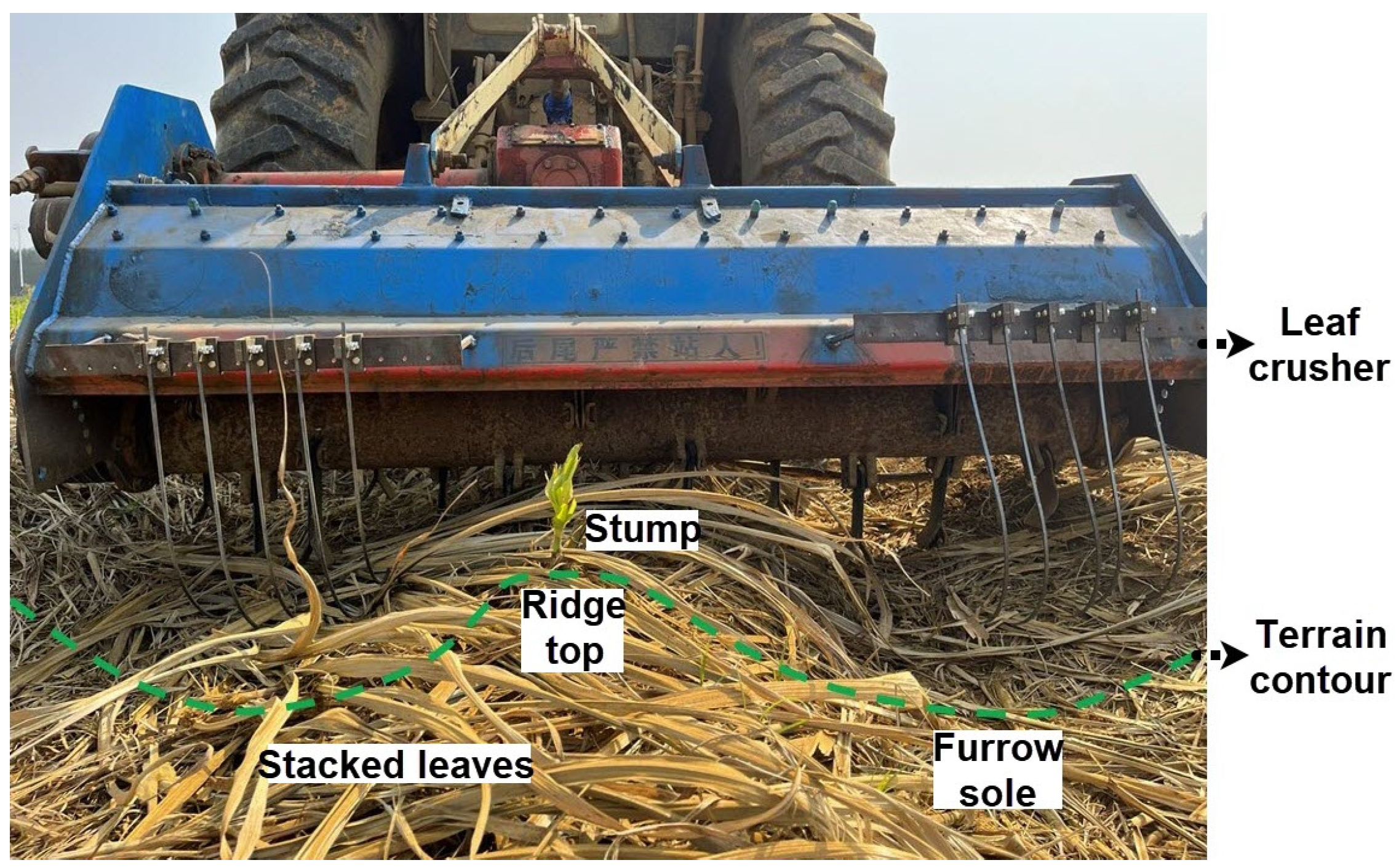
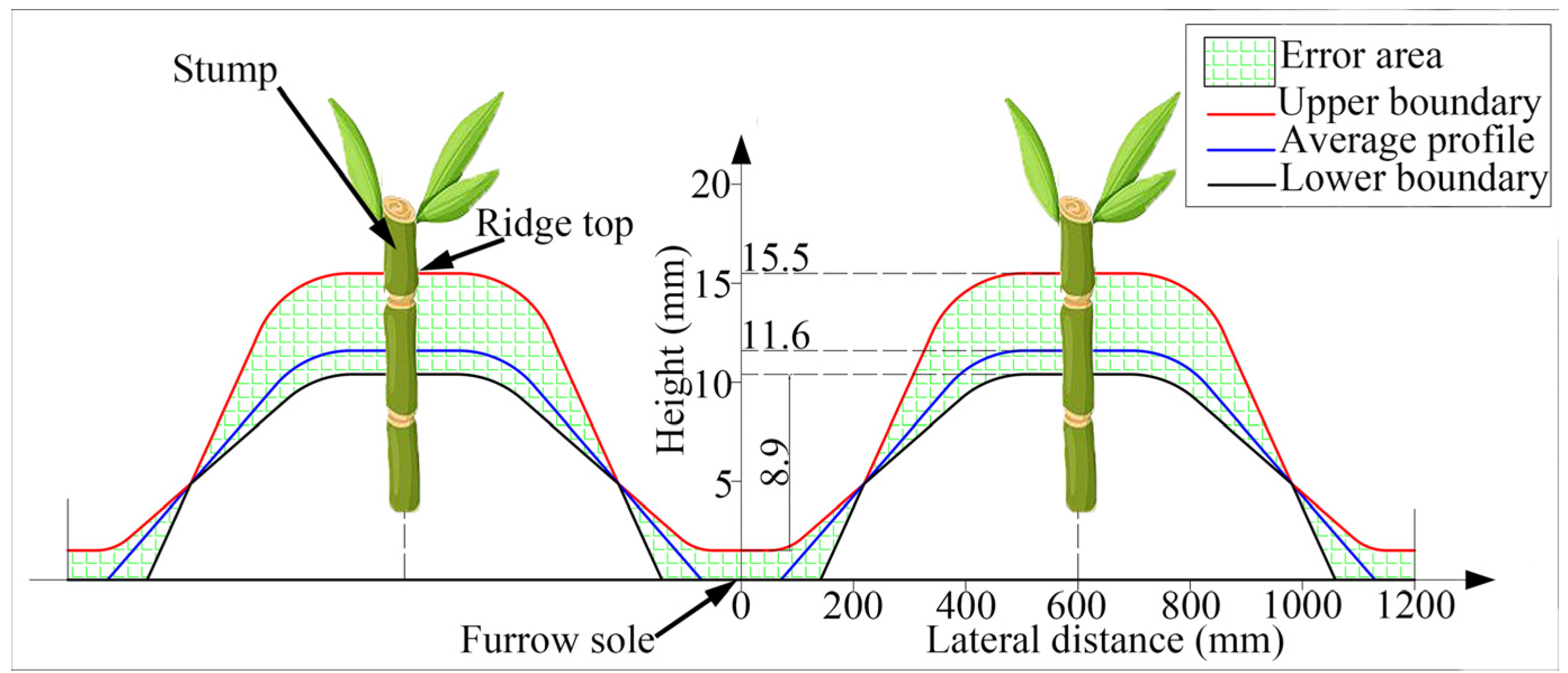
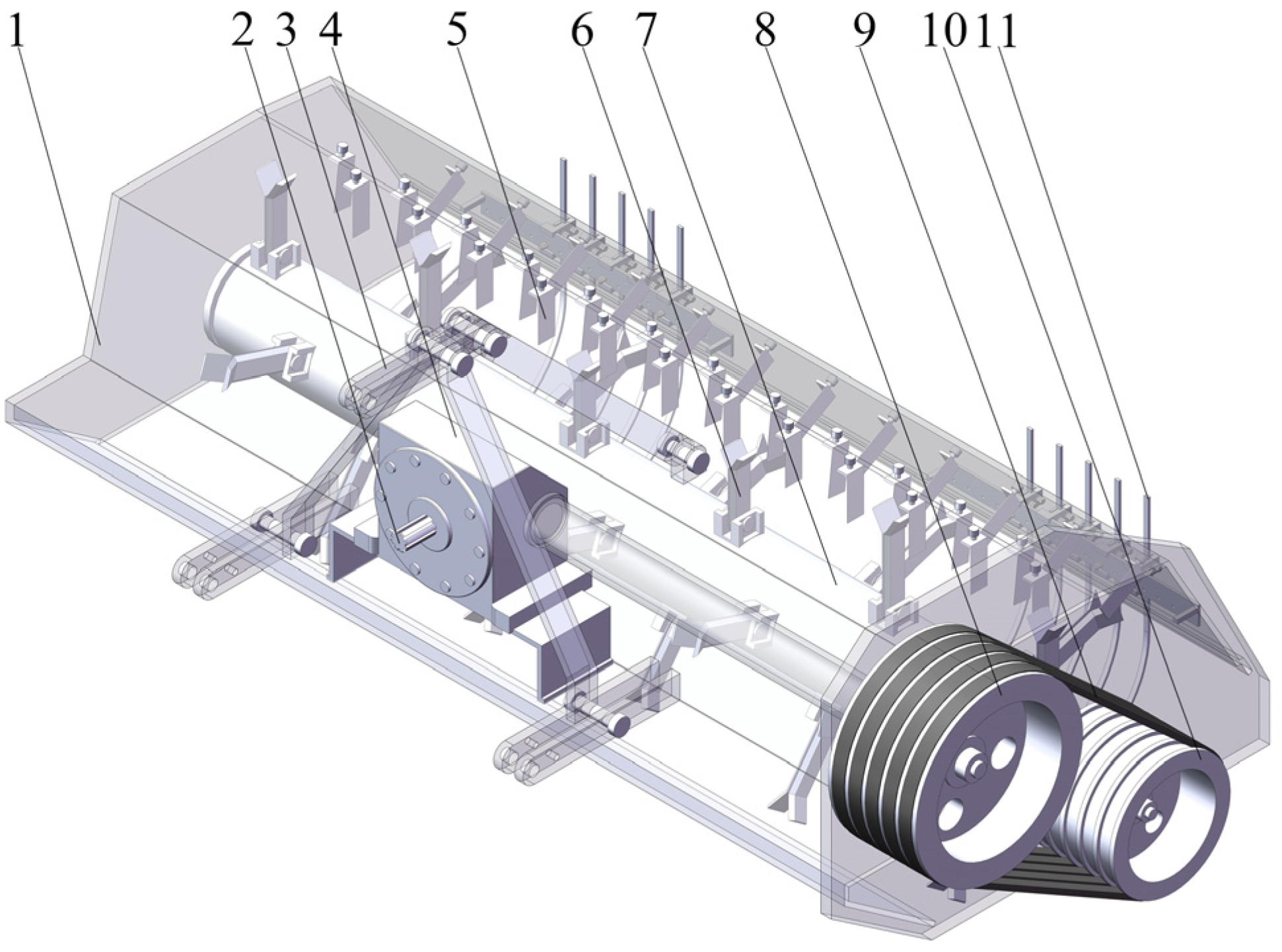
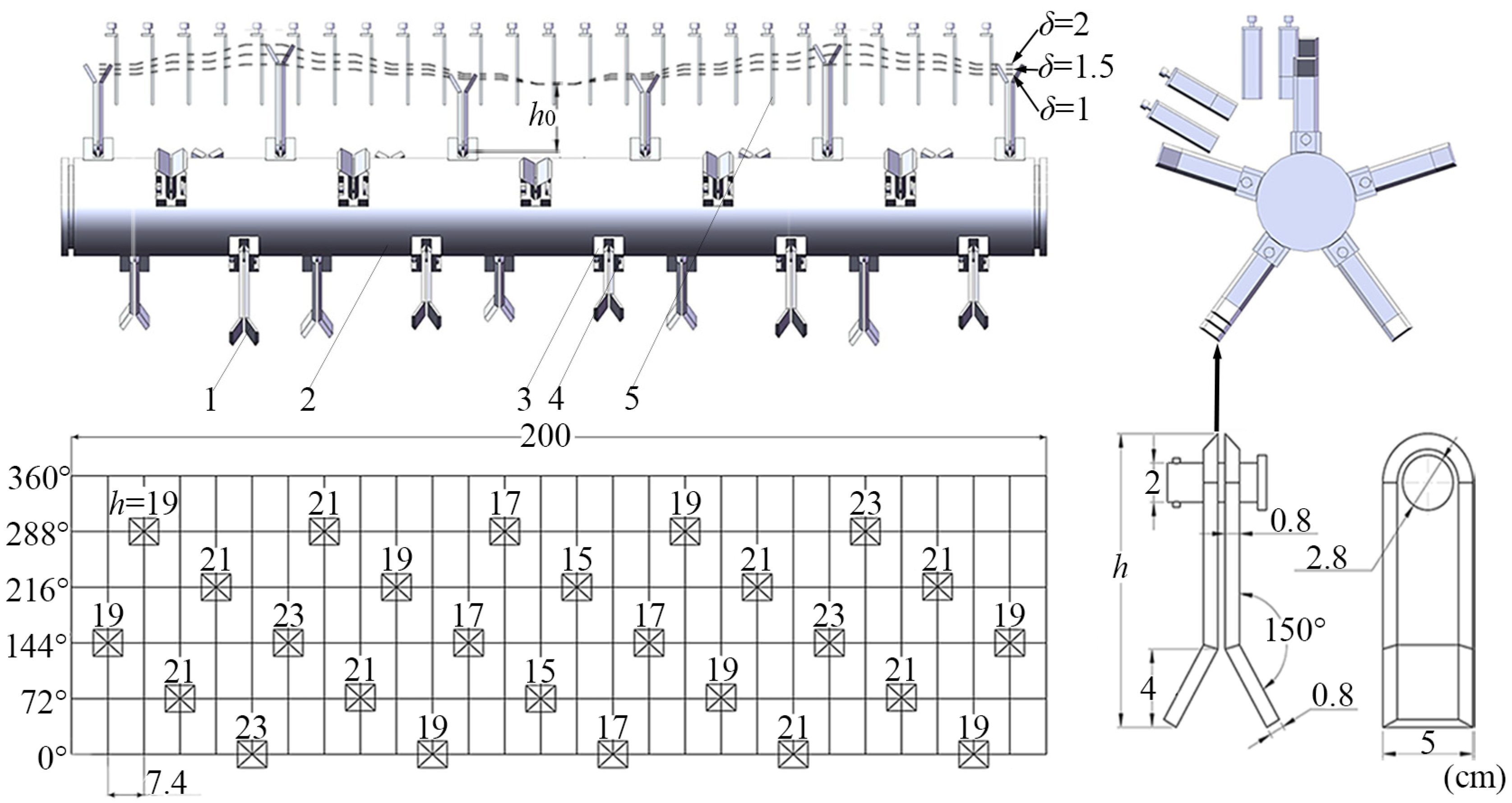
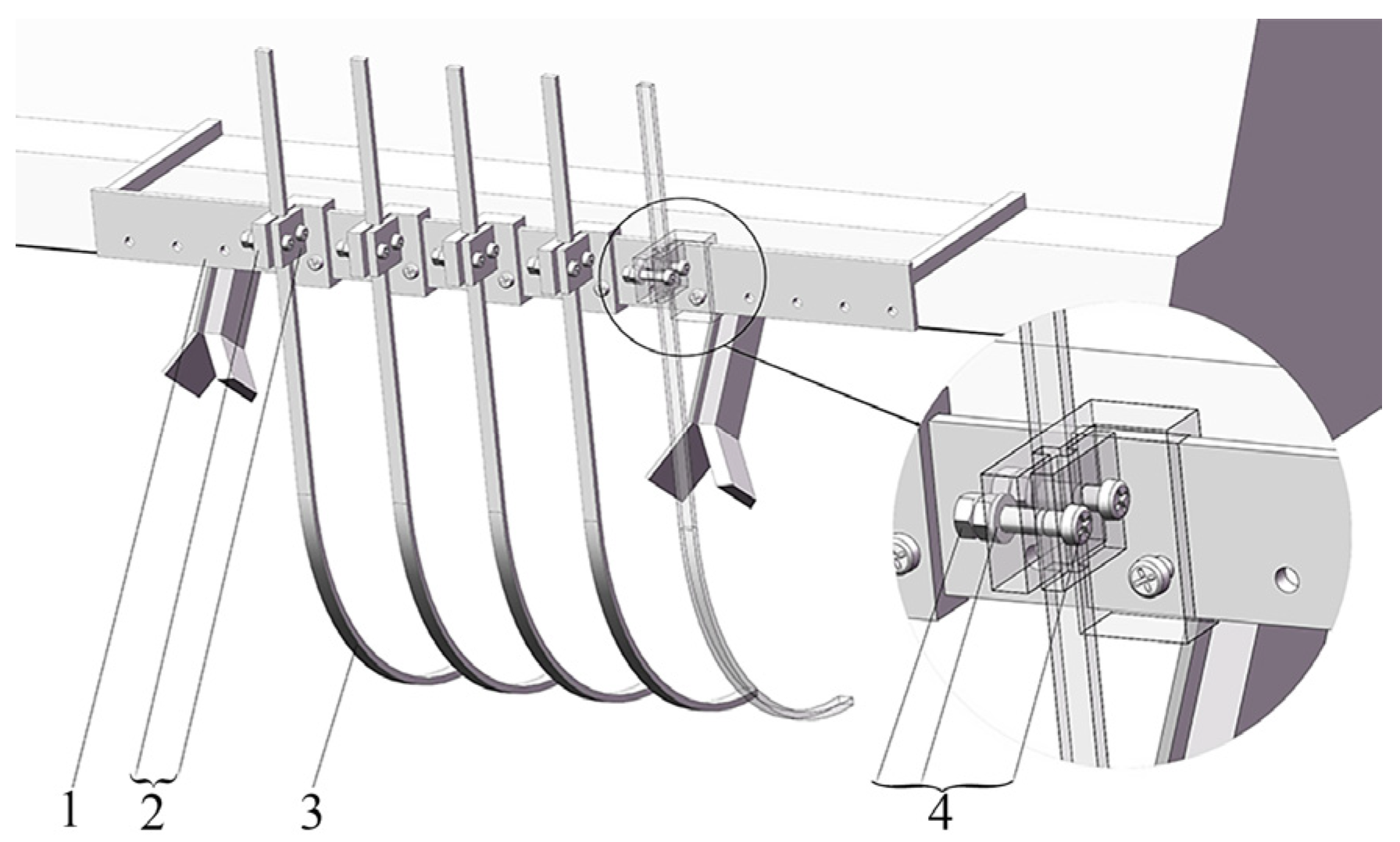
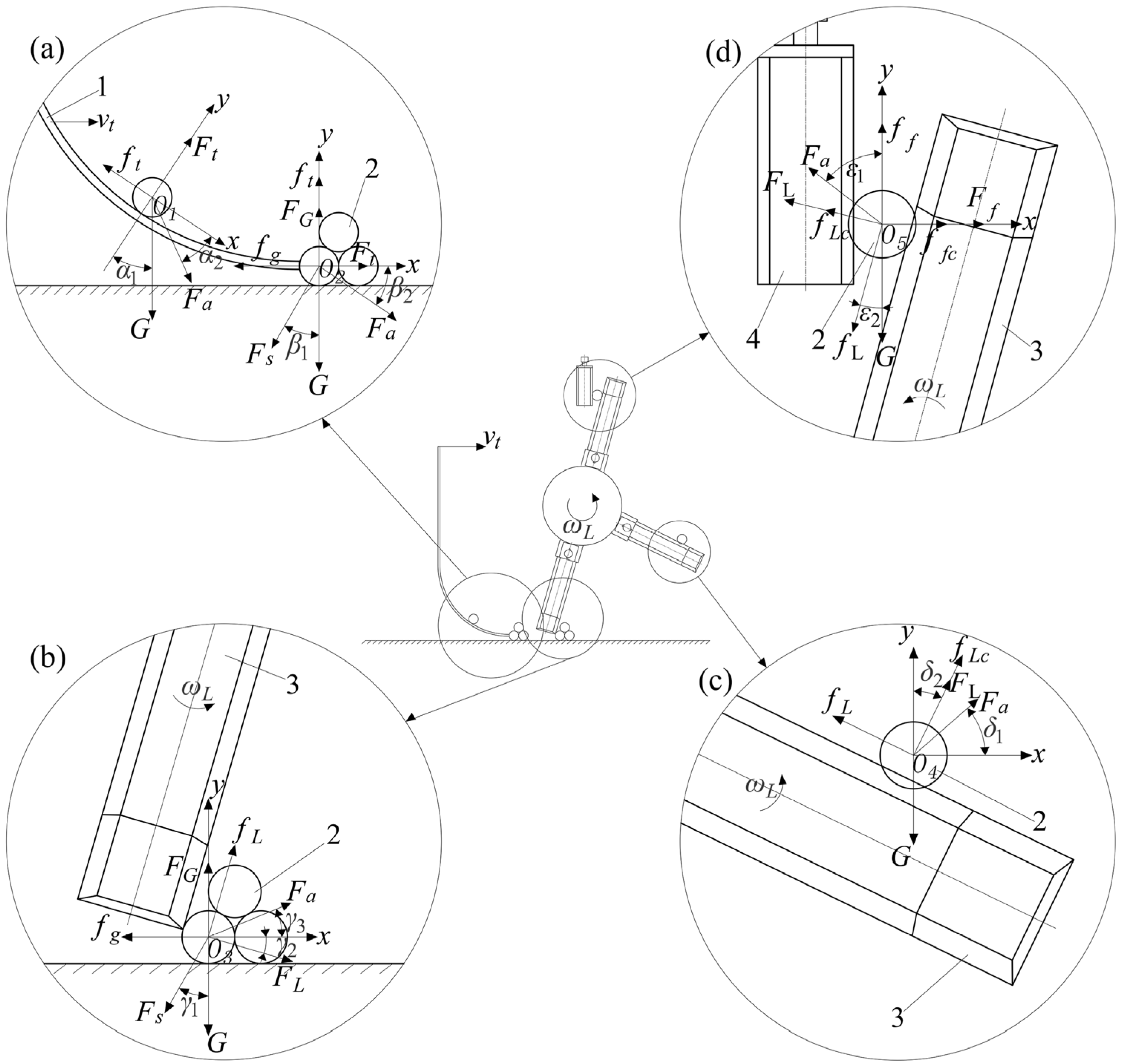

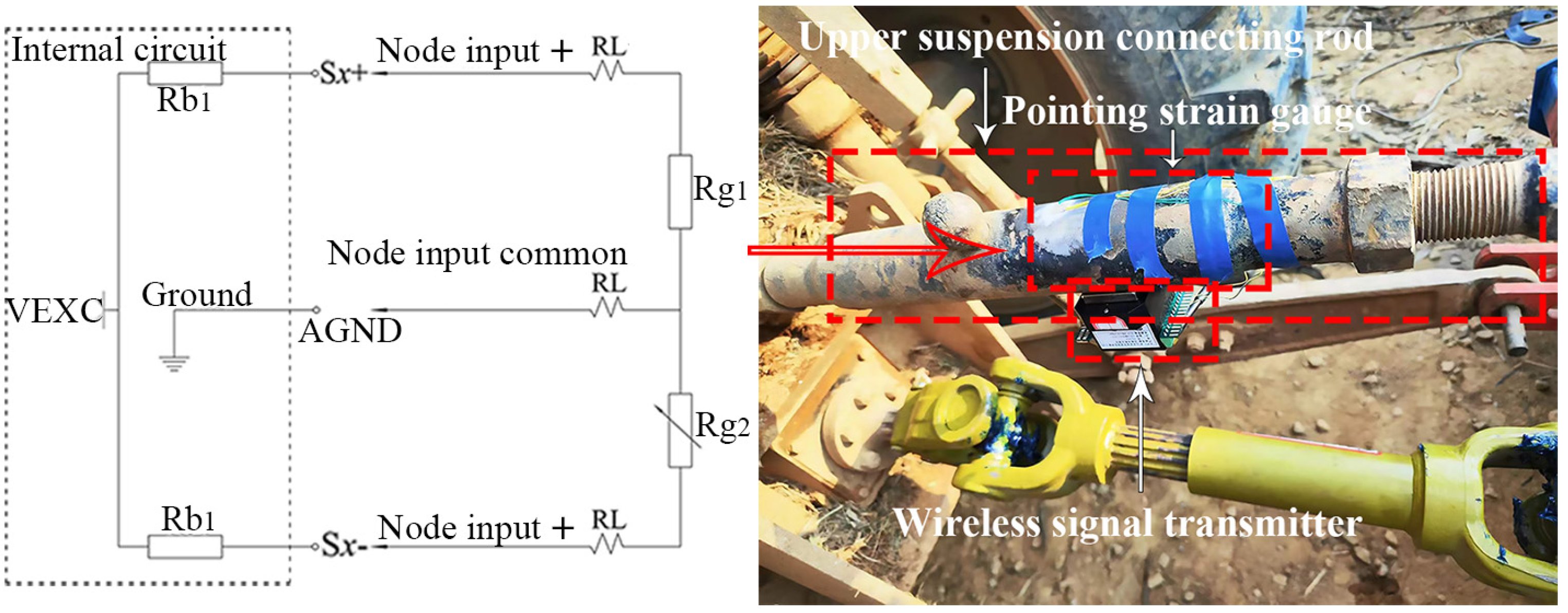



| Parameters | Details |
|---|---|
| Machine dimension (mm) | 2200 × 1350 × 1100 |
| Total mass (kg) | 565 |
| Working breadth (mm) | 2000 |
| Roller rotation speed (rpm) | 1900~2100 |
| Implement forward speed (km/h) | 3~5 |
| Supporting motive power (kW) | 90 |
| S. No | Experimental Factors | Experimental Indicators | |||
|---|---|---|---|---|---|
| Blade Length Gradient, A (cm) | Teeth Spacing, B (cm) | Feed Speed, C (km/h) | CQR (%) | CFD | |
| 1 | 1 (2.0) | −1 (3.5) | 0 (4.0) | 65.35 ± 3.12 | 0.139 ± 0.011 |
| 2 | 1 | 1 (10.5) | 0 | 65.43 ± 2.99 | 0.126 ± 0.010 |
| 3 | 1 | 0 (7.0) | −1 (3.0) | 75.92 ± 3.01 | 0.112 ± 0.010 |
| 4 | 1 | 0 | 1 (5.0) | 75.59 ± 2.10 | 0.114 ± 0.004 |
| 5 | −1 (1.0) | −1 | 0 | 52.44 ± 2.02 | 0.161 ± 0.007 |
| 6 | −1 | 1 | 0 | 57.93 ± 1.81 | 0.152 ± 0.010 |
| 7 | −1 | 0 | −1 | 70.29 ± 2.46 | 0.121 ± 0.006 |
| 8 | −1 | 0 | 1 | 59.04 ± 1.25 | 0.140 ± 0.010 |
| 9 | 0 (1.5) | −1 | −1 | 72.27 ± 2.21 | 0.117 ± 0.003 |
| 10 | 0 | 1 | −1 | 70.17 ± 2.61 | 0.114 ± 0.006 |
| 11 | 0 | −1 | 1 | 60.42 ± 2.85 | 0.151 ± 0.009 |
| 12 | 0 | 1 | 1 | 70.02 ± 1.51 | 0.112 ± 0.008 |
| 13 | 0 | 0 | 0 | 82.01 ± 2.15 | 0.099 ± 0.009 |
| 14 | 0 | 0 | 0 | 84.82 ± 2.45 | 0.096 ± 0.003 |
| 15 | 0 | 0 | 0 | 82.13 ± 2.13 | 0.101 ± 0.006 |
| 16 | 0 | 0 | 0 | 80.25 ± 2.10 | 0.107 ± 0.006 |
| 17 | 0 | 0 | 0 | 80.12 ± 2.44 | 0.106 ± 0.003 |
| Experimental Indicators | Source | Sum of Squares | DF | Mean Square | F Value | p Value | Sig |
|---|---|---|---|---|---|---|---|
| CQR | Model | 1471.27 | 9 | 163.47 | 74.52 | <0.0001 | ** |
| A | 226.74 | 1 | 226.74 | 103.36 | <0.0001 | ** | |
| B | 21.35 | 1 | 21.35 | 9.73 | 0.0168 | * | |
| C | 69.50 | 1 | 69.50 | 31.68 | 0.0008 | ** | |
| AB | 7.32 | 1 | 7.32 | 3.34 | 0.1105 | ||
| AC | 29.81 | 1 | 29.81 | 13.59 | 0.0078 | ** | |
| BC | 34.22 | 1 | 34.22 | 15.60 | 0.0055 | ** | |
| A2 | 403.90 | 1 | 403.90 | 184.12 | <0.0001 | ** | |
| B2 | 584.71 | 1 | 584.71 | 266.54 | <0.0001 | ** | |
| C2 | 14.59 | 1 | 14.59 | 6.65 | 0.0365 | * | |
| Error | 15.36 | 7 | 2.19 | ||||
| Total | 1486.63 | 16 | |||||
| CFD | Model | 61.55 | 9 | 6.84 | 26.20 | 0.0001 | ** |
| A | 8.61 | 1 | 8.61 | 32.99 | 0.0007 | ** | |
| B | 5.01 | 1 | 5.01 | 19.20 | 0.0032 | ** | |
| C | 3.63 | 1 | 3.63 | 13.91 | 0.0074 | ** | |
| AB | 0.029 | 1 | 0.029 | 0.11 | 0.7491 | ||
| AC | 0.69 | 1 | 0.69 | 2.64 | 0.1480 | ||
| BC | 3.21 | 1 | 3.21 | 12.31 | 0.0099 | ** | |
| A2 | 16.94 | 1 | 16.94 | 64.91 | <0.0001 | ** | |
| B2 | 21.16 | 1 | 21.16 | 81.04 | <0.0001 | ** | |
| C2 | 0.007 | 1 | 0.007 | 0.026 | 0.8756 | ||
| Error | 1.83 | 7 | 0.26 | ||||
| Total | 63.38 | 16 |
Disclaimer/Publisher’s Note: The statements, opinions and data contained in all publications are solely those of the individual author(s) and contributor(s) and not of MDPI and/or the editor(s). MDPI and/or the editor(s) disclaim responsibility for any injury to people or property resulting from any ideas, methods, instructions or products referred to in the content. |
© 2024 by the authors. Licensee MDPI, Basel, Switzerland. This article is an open access article distributed under the terms and conditions of the Creative Commons Attribution (CC BY) license (https://creativecommons.org/licenses/by/4.0/).
Share and Cite
Zhang, B.; Gao, C.; Shen, W.; Chen, B. Design and Experiment of Profiling Furrow-Ridge Terrain by Cane Leaf-Chopping and Returning Machine. Agriculture 2024, 14, 413. https://doi.org/10.3390/agriculture14030413
Zhang B, Gao C, Shen W, Chen B. Design and Experiment of Profiling Furrow-Ridge Terrain by Cane Leaf-Chopping and Returning Machine. Agriculture. 2024; 14(3):413. https://doi.org/10.3390/agriculture14030413
Chicago/Turabian StyleZhang, Biao, Cheng Gao, Weimin Shen, and Baoshan Chen. 2024. "Design and Experiment of Profiling Furrow-Ridge Terrain by Cane Leaf-Chopping and Returning Machine" Agriculture 14, no. 3: 413. https://doi.org/10.3390/agriculture14030413




